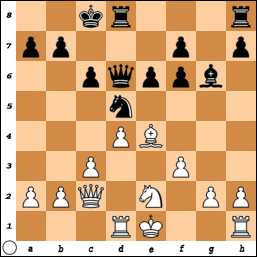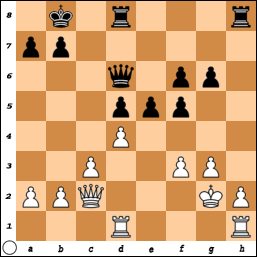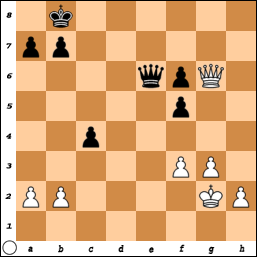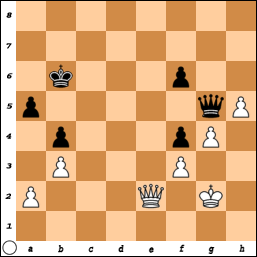Thursday 8 October 2015
White: P. Shevlake (158) - Black: K. Nevols
My first home game and a tough proposition - a player graded far higher than I (my provisional grade is 122).
1. e4 d5
This is the Centre Counter or the Scandinavian defence. I discovered it in the mid-80s on one of Mike Basman's Audio Chess cassettes and have played it many times. It is a very solid defence and useful when playing Black against a stronger opponent.
2. exd5
2. e4 goes into the Blackmar-Diemar Gambit.
2. ... Qxd5
Many players play 2. ... Nf6 3. d4 Nxd5
3. Nc3 Qa5
The main line. Qe5+ and Qd8 are both playable, and I read recently that Qd6 has come into fashion. But I will stick to what I know.
4. d4 Nf6
5. Bd2 c6
6. Bd3 Bg4
I have sometimes found it to be an issue where to put my white-square Bishop - f5 or g4. (It often ends up getting exchanged on g6). The move order White has chosen forces me to make this choice before Nf3. Here 6. ... Bf5 walks into 7. b4 so it has to go onto g4.
7. f3 Bh5
8. Nge2 e6
9. Ne4 Qb6

Usually Black plays Qc7 and then Bd6 but here 9. ... Qc7 is met by 10. Bf4 where I don't have the option of Bd6 and the d6 square becomes a problem.
10. Nxf6 gxf6
This opening often ends up with odd pawn structures on the kingside, but perfectly sound.
11. Qc1 Bd6
12. Be3 Qc7
13. Bf4 Nd7
14. Bxd6 Qxd6
15. c3
All quiet moves as White slowly sorts his position out, but at this stage I was not too concerned. I still have the options of pawn breaks and moving the knight into the centre.
15. ... Bg6
As earlier stated, the Bishop ends up on g6. If White were to play Bxg6 then hxg6 and the h-file becomes a possible route of attack.
16. Be4 O-O-O
Not 16. Bxe4 where after fxe4 and O-O White has pressure in the centre and along the f-file.
17. Qc2 Nb6
Heading for the d5 square. White now has 60 minutes left for 18 moves while I had 42 minutes. (The time limit was 35 moves in 75 minutes and then 15 more for the rest of the game). The game is dead even.
18. Rd1 Nd5

The Knight often ends up here in this system. If White plays c4 then the d-pawn becomes a target. Meanwhile Black has options of using the f4 square or playing for an e5 or c5 break.
(The computer here suggests 18. .. f5!?. The idea is 19. Bd3 Nd5 with an eye on the e3 square. Then 20. Qd2 f4 with Ne3 to follow. An imaginative idea as normally one does not see a move which would suffocate one's own bishop)
19. Kf2
Defending the e3 square.
19. ... Kb8
Moving away from the Queen's file in case of a quick c4 and d5.
20. g3
Protecting the f4 square. Now I have to think of how I can get some play against his King and/or in the centre.
20. ... f5
And decide to go for an f-file push (belatedly as above). 21. Bd3 f4 looked good to me. After 22. gxf4 Nxf4 there is a danger that the f-pawn could become weak.
(Again our more ambitious electronic ally goes one better opting for 20 ... e5 and if 21. dxe5 then 21. ... Qc5+ with Ne3 to follow).
21. Bxd5 cxd5
Now you can see why I moved my King off the c-file. 22. c4 can now be answered by 22. .. Rc8
22. Nf4 f6
White has 53 minutes left for 13 moves and Black has 31 minutes - so no problems there.
23. Nxg6 hxg6
24. Kg2 e5
The problem with this was to weaken the d5 point but I was beginning to like the look of my central pawn mass.

25. c4!?
This begins an interesting pawn sacrifice. White dissolves the centre to get his pieces into play and a strong attack down the centre.
25. ... dxc4
I didn't like 25. ... Rc8 now. Perhaps it is OK but I was a bit nervous with dxe5 possibilities and my Queen stuck where it is.
26. dxe5 Qxe5
27. Rhe1 Qc5
28. Re6 Rxd1
29. Qxd1 Rf8
30. Qd7
30. Rxf6 with Qd8+ would have got the pawn back.
30 ... Qc7
I wondered for a moment if this was an error and whether Qc8 was safer but then Qd6+ picks up the f-pawn.
31. Re8+ Rxe8
32. Qxe8 Qc8
33. Qxg6 Qe6

So here we are in the ending - Queen and five pawns each. White has the better pawn structure, a passed h-pawn, the safer King and an active Queen. Black also has an active Queen and needs to get moving on the queenside. Now I was thinking of drawing possibilities with perpetual check.
34. Kh3
Taking the King away from any checks but walking into the Queen diagonal and giving me thoughts of how I can work the f4 check.
34. ... b5
35. Qh5 b4
Maybe a6 is better to keep the pawn chain.
36. Qh8+ Kb7
37. Qf8! a5
38. Qc5 Qe5?
This is known as 'chess blindness' - I completely overlooked that the c-pawn was now loose. Maybe 38. ... f4+ 39. g4 Qc6 to try to get counter play against the f3 pawn as well as push with c3, or simply 38. ... Ka6.
39. Qxc4 Kb6
40. Qc2 Qe6
Now White is a clear pawn up and with the precise white Queen movements, I had the impression of being outplayed. On the other hand, White's kingside is not moving.
41. b3 Qd7
42. Kg2 Qe6
43. h4 Qd7
44. Qe2 Qf7
45. Kf2 Qd5
46. h5
Now it is looking gloomy as the h-pawn is on its way.
46. .... f4
47. g4 Qc5+
48. Kg2 Qg5
With plans of Qh4 and then into g3.

49. Kh3 Qd5
50. Qe4?!
Now the light bulb goes on. This lets my Queen in to have a go at a swindle. Maybe 50. Qf2+ is a better option with h6. Or simply 50. h6 straight away.
50. ... Qd1
51. Qxf4?
If 51. Kg2 Qd2+ 52. Kf1 Qd1 53. Qe1 Qd3+ 54. Kg2 and Black can't play Qc2+ due to Qf2.
Now White told me afterwards he was expecting 51. .. Qh1+ 52. Qh2 Qxf3+ 53. Kh4 but .....
51. ... Qf1+!
... straight away forcing the draw.
52. Kh2 Qf2+
Drawn through perpetual check. A lucky escape.
No comments:
Post a Comment